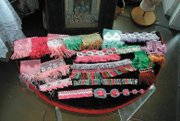Private Fashion Archive Opens for Designers
It’s the nightmare of every designer.
A stressful deadline looms, and every design completed is missing that crucial quality that would turn the garment into a must-buy. It’s time to call in reinforcements.
Doris Raymond thinks she has the solution.
In late September, Raymond will open a private, for-profit research library called Inspiration Space at 334 S. La Brea Ave. in Los Angeles. It will be adjacent to her vintage store, The Way We Wore, at 336 S. La Brea Ave.
In the past year, Raymond has pulled historic garments for fashion luminaries such as Zac Posen and Consuelo Castiglione of Italian design house Marni. Her archives—which contain more than 500,000 garments, textiles, trims and sketchbooks dating from the 18th century to the 1980s—have been an open secret in the design community.
All under one roof, designers have been able to find trim manufactured in 18th century France, intricate Shibori-dyed garments made 90 years ago in Japan, and sketchbooks of classic dresses etched by fashion students in 1966. Demand has grown so much that Raymond has decided to make the library a separate business.
Designer Maggie Norris applauded the decision. Norris said Raymond knows a designer’s needs as well as an expert history professor knows a specific historic era.
“I can call, and she’ll understand immediately,” said Norris, owner of New York–based Maggie Norris Couture.
Norris said she typically contacts Raymond when fashioning a one-of-a-kind dress. The designer purchased some 1950s cocktail dresses early this year for inspiration in creating several dresses that she sold to New York’s Bergdorf Goodman department store.
Design for a price
Designers will pay a minimum of $500 for a session at the 1,500-square-foot archive, where Raymond will act as librarian and pull any materials her clients request.
A typical session may run something like this: If a client is interested in creating the next bohemian skirt, Raymond will pick historic designs that would complement a modern bohemian skirt, such as a shawl from Peru, a jacket from Czarist Russia or an Indian sari. For a price, her clients can take home the pieces that inspire them. The average cost for prints and other pieces will range from $200 to $300. A swatch will go for as little as $75.
While many fashion colleges offer their own collections of historic costumes and a simple Google search can locate images of ancient fabrics, Raymond said her library can save designers time and labor in fabrication and sourcing.
“If you think about how much time it takes to come up with a concept, sketching a sample or making a drawing into a fiber sample, [you realize] you eliminate those steps when you buy a swatch,” Raymond said.
She estimated that by using her archive, designers can save hundreds of dollars in research and fabrications.
Fashion sleuth
Raymond has spent her life in fabric research. Her passion started when, as a teen-ager in New York’s Long Island, she scoured New York for spectacular vintage pieces she could wear to school.
Her avocation became her vocation. From 1988 to 2002, she co-owned the Vintage Fashion Expo, a marketplace of 65 to 100 vintage clothing dealers that holds shows in Santa Monica, Calif., and San Francisco. She collected a warehouse of materials that she sold to museums and occasionally to film wardrobers. Films continue to make up 1 percent of her business.
Because of Raymond’s growing reputation, people began tipping her off when someone was going to sell mint-condition dresses from the 1920s or a fur coat worn by a Russian noble in the 1880s. In the past 10 years, she also has traveled extensively to collect pieces from Asia and Latin America.
Raymond will keep some of her archives in the Inspiration Space. Another part of the collection will be in a warehouse in San Francisco, which was her home as recently as 2004. At both places, she said her antique clothes are safe from the culprits that destroy garments: mice, moths, silverfish, mildew, humidity and dust.
Raymond said one of her greatest pleasures is preserving the pieces.
“I deal in beautiful things,” she said. “They’re the grandparents of today’s fashions, and they deserve respect and a second life. I get a thrill when I see how my things get introduced into a contemporary vein.” —Andrew Asch























